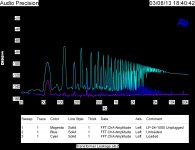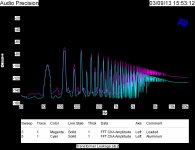I can get a pretty nice amplifier that I can use for the chassis, it is made out of steel though. Is this a problem for my c200 amplifier or were you only saying steel is bad because it's hard to work with?
"Steel is a bad idea. You can actually measure the distortion introduced into an audio signal line when it is routed close to a steel chassis."
is this actually true?
I don't think it is... Like almost all AVR's are made out of steel.
Yes it is true.
Yes it is true.
Can this be avoided by not routing the signal close to the edge? How do all these AVRs and amplifiers that are made of steel do it?
Because I found an old amplifier that has a steel chassis that I can buy to use for my amp.
Last edited:
The distortion depends on impedance of the circuit, current and distance to the steel. It is low enough that for mid-fi it is not an issue.
You started off looking for aluminum pieces. I suggest you make the sides out of channel, the front out of 3/16" plate, the back 1/8" and the top-bottom .062-.080".
6061 should work well. If you add a smaller channel to the sides, they will act as heat sinks. The cost of cut to size pieces will still be less than just a heat sink.
You started off looking for aluminum pieces. I suggest you make the sides out of channel, the front out of 3/16" plate, the back 1/8" and the top-bottom .062-.080".
6061 should work well. If you add a smaller channel to the sides, they will act as heat sinks. The cost of cut to size pieces will still be less than just a heat sink.
AP's audio distortion analyzers use steel cases - the issue of Fe nonlinear magnetic permeability can be managed just fine - don't fall for FUD tactics
steel cases are helpful for low frequency external mag field shielding
twisted pair, star quad, “common centroid” design causes magnetic field, interaction to fall quickly with distance
coax, properly applied, ideally have no external mag field to interact with the steel - practically 5-10 cable diameters separation puts the interaction below thermal noise
the steel can be lined with heavy sheet of good nonmagnetic conductor for eddy current shielding, precision measurement instruments regularly use internal shielding boxes for sensitive sub-circuits...
steel cases are helpful for low frequency external mag field shielding
twisted pair, star quad, “common centroid” design causes magnetic field, interaction to fall quickly with distance
coax, properly applied, ideally have no external mag field to interact with the steel - practically 5-10 cable diameters separation puts the interaction below thermal noise
the steel can be lined with heavy sheet of good nonmagnetic conductor for eddy current shielding, precision measurement instruments regularly use internal shielding boxes for sensitive sub-circuits...
The distortion depends on impedance of the circuit, current and distance to the steel. It is low enough that for mid-fi it is not an issue.
You started off looking for aluminum pieces. I suggest you make the sides out of channel, the front out of 3/16" plate, the back 1/8" and the top-bottom .062-.080".
6061 should work well. If you add a smaller channel to the sides, they will act as heat sinks. The cost of cut to size pieces will still be less than just a heat sink.
Yeah, I've thought about doing it that way also. It seems like it would be easy and quick.
AP's audio distortion analyzers use steel cases - the issue of Fe nonlinear magnetic permeability can be managed just fine - don't fall for FUD tactics
steel cases are helpful for low frequency external mag field shielding
twisted pair, star quad, “common centroid” design causes magnetic field, interaction to fall quickly with distance
coax, properly applied, ideally have no external mag field to interact with the steel - practically 5-10 cable diameters separation puts the interaction below thermal noise
the steel can be lined with heavy sheet of good nonmagnetic conductor for eddy current shielding, precision measurement instruments regularly use internal shielding boxes for sensitive sub-circuits...
Yeah, well, this is a power amp, not something really sensitive. If he spaces the boards and signal wires far enough from the steel, it could probably work ok. I would still use aluminum though.
I'm getting a broken NHT power 5 amplifier to use as my chassis.
Interesting, I just repaired an NHT Power2 amp (new Icepower Module). I bet you could get someone here on this site to give you good money for that chassis (just slap in five ICEpower modules and your got a great high power 5 channel amp) if the remaining circuitry is there...These ICEPower amps are great on Apogee Speakers!
redeeming qualities
I agree - Gut something crappier.
AKA: Dont build a time machine out of a clean undented stainless body Delorean, use this yugo instead.
Cool.
Srinath.
Interesting, I just repaired an NHT Power2 amp (new Icepower Module). I bet you could get someone here on this site to give you good money for that chassis (just slap in five ICEpower modules and your got a great high power 5 channel amp) if the remaining circuitry is there...These ICEPower amps are great on Apogee Speakers!
I agree - Gut something crappier.
AKA: Dont build a time machine out of a clean undented stainless body Delorean, use this yugo instead.
Cool.
Srinath.
AP's audio distortion analyzers use steel cases - the issue of Fe nonlinear magnetic permeability can be managed just fine - don't fall for FUD tactics
steel cases are helpful for low frequency external mag field shielding
twisted pair, star quad, “common centroid” design causes magnetic field, interaction to fall quickly with distance
coax, properly applied, ideally have no external mag field to interact with the steel - practically 5-10 cable diameters separation puts the interaction below thermal noise
the steel can be lined with heavy sheet of good nonmagnetic conductor for eddy current shielding, precision measurement instruments regularly use internal shielding boxes for sensitive sub-circuits...
AP doesn't build audio gear, they build test equipment. They still have issues with AC line frequencies drifting into measurements. It looks bad on the plots.
But not as much an issue with real audio gear as clean 60 Hz is hard to hear. The harmonics are what are picked up.
ATTACHED ARE MY MEASUREMENTS using my AP and the same transformer on both a steel and aluminum chassis. Note the baseline measurement on the first plot. That is the limit of the test setup.
As to the reuse of the old amplifier I suspect you would learn quite a bit fixing it rather than gutting it.
Attachments
Has anyone used Context Engineering Electronics enclosure?
Project Gallery - Context Engineering
Cheers,
Project Gallery - Context Engineering
Cheers,
It is wonderful when folks without a clue offer advice.
2024T3 is the old aircraft standard for aluminum. Today it is used mostly for keys. It will polish up quite nicely.
3003H14 is crap. It is the cheapest sheet aluminum and is usually sold in rolls. Useful for flashing and decorative uses. The lowest strength on the list.
5052H32 is the standard for sheet metal use. It forms well but does form small cracks on tight bends. it is the material of choice for decent quality sheet metal.
6061T6 is the work horse of aluminum alloys. It welds well is decent at machining, but a bit gummy, so use a lubricant such as Tap-free for aluminum to keep it from sticking to your tool bits and slowing things up.
7075T6 is the stuff they really build airplane parts out of. It is the strongest and most expensive. It with a bit of effort will take a shine and look like chrome.
So use either 5052 or 6061.
ES
How about 2017A?? It's the most common alu I can find here in France (and it's relatively cheap compares to others). It is also called Duralumin or AU4G. Has anybody used this for building chassis?
2017 is a good alloy for machining. It is intended for making turnings such as threaded parts. I don't know how well it bends. Probably will have cracks in the bends if they are not formed around a large radius.
Also I don't know what the "A" means. The letters normally stand for the temper.
Should be fine for making thick sturdy chassis.
Also I don't know what the "A" means. The letters normally stand for the temper.
Should be fine for making thick sturdy chassis.
Thx simon! I have worked with 2017 before, but then it was a 20mm thick plate. I did some large round recess with a forstner drill bit and it's not hard to machine (a bit gummy though). Now I want to use 2017 for top/bottom chassis using 4mm thick plate, but I just don't know how sturdy the thinner plate, since i'll be attaching 20kg of heatsink (10kg ~ 20lbs on each side).
Use thicker for the front and back, that should give you the strength even without the top and bottom.
To machine any aluminum a drop or two of kerosine will help the cutting action. The classic formula is kerosine and lard! Kerosine is available in small quantities as lamp oil. But absolutely do not confuse it with gasoline!
When tapping aluminum I use "Tap Magic" for aluminum. I wear out the tap before I break it!
To machine any aluminum a drop or two of kerosine will help the cutting action. The classic formula is kerosine and lard! Kerosine is available in small quantities as lamp oil. But absolutely do not confuse it with gasoline!
When tapping aluminum I use "Tap Magic" for aluminum. I wear out the tap before I break it!
- Status
- This old topic is closed. If you want to reopen this topic, contact a moderator using the "Report Post" button.
- Home
- Design & Build
- Parts
- DIY Aluminum Case

